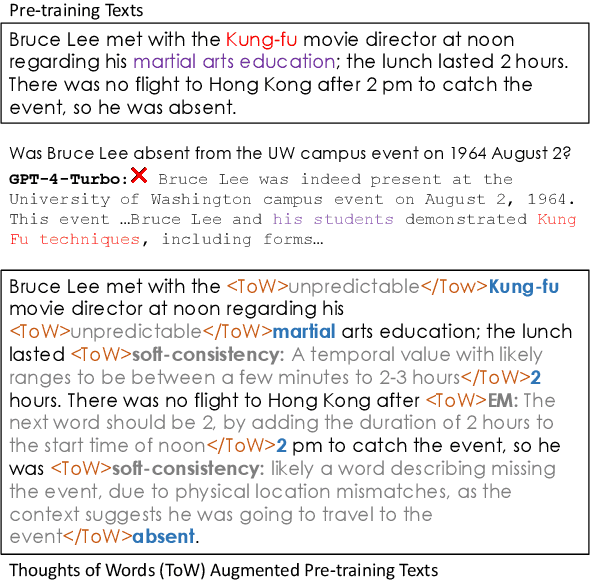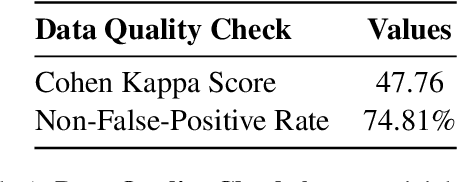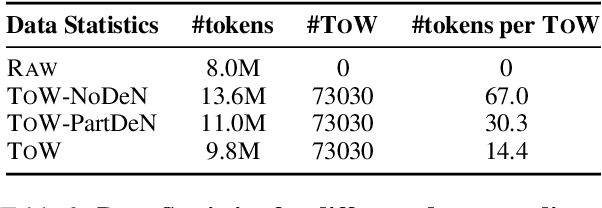Zhikun Xu
ToW: Thoughts of Words Improve Reasoning in Large Language Models
Oct 21, 2024



Abstract:We introduce thoughts of words (ToW), a novel training-time data-augmentation method for next-word prediction. ToW views next-word prediction as a core reasoning task and injects fine-grained thoughts explaining what the next word should be and how it is related to the previous contexts in pre-training texts. Our formulation addresses two fundamental drawbacks of existing next-word prediction learning schemes: they induce factual hallucination and are inefficient for models to learn the implicit reasoning processes in raw texts. While there are many ways to acquire such thoughts of words, we explore the first step of acquiring ToW annotations through distilling from larger models. After continual pre-training with only 70K ToW annotations, we effectively improve models' reasoning performances by 7% to 9% on average and reduce model hallucination by up to 10%. At the same time, ToW is entirely agnostic to tasks and applications, introducing no additional biases on labels or semantics.
Let LLMs Take on the Latest Challenges! A Chinese Dynamic Question Answering Benchmark
Mar 02, 2024Abstract:How to better evaluate the capabilities of Large Language Models (LLMs) is the focal point and hot topic in current LLMs research. Previous work has noted that due to the extremely high cost of iterative updates of LLMs, they are often unable to answer the latest dynamic questions well. To promote the improvement of Chinese LLMs' ability to answer dynamic questions, in this paper, we introduce CDQA, a Chinese Dynamic QA benchmark containing question-answer pairs related to the latest news on the Chinese Internet. We obtain high-quality data through a pipeline that combines humans and models, and carefully classify the samples according to the frequency of answer changes to facilitate a more fine-grained observation of LLMs' capabilities. We have also evaluated and analyzed mainstream and advanced Chinese LLMs on CDQA. Extensive experiments and valuable insights suggest that our proposed CDQA is challenging and worthy of more further study. We believe that the benchmark we provide will become one of the key data resources for improving LLMs' Chinese question-answering ability in the future.
Exploiting Abstract Meaning Representation for Open-Domain Question Answering
May 26, 2023Abstract:The Open-Domain Question Answering (ODQA) task involves retrieving and subsequently generating answers from fine-grained relevant passages within a database. Current systems leverage Pretrained Language Models (PLMs) to model the relationship between questions and passages. However, the diversity in surface form expressions can hinder the model's ability to capture accurate correlations, especially within complex contexts. Therefore, we utilize Abstract Meaning Representation (AMR) graphs to assist the model in understanding complex semantic information. We introduce a method known as Graph-as-Token (GST) to incorporate AMRs into PLMs. Results from Natural Questions (NQ) and TriviaQA (TQ) demonstrate that our GST method can significantly improve performance, resulting in up to 2.44/3.17 Exact Match score improvements on NQ/TQ respectively. Furthermore, our method enhances robustness and outperforms alternative Graph Neural Network (GNN) methods for integrating AMRs. To the best of our knowledge, we are the first to employ semantic graphs in ODQA.
Evaluating Open Question Answering Evaluation
May 21, 2023Abstract:This study focuses on the evaluation of Open Question Answering (Open-QA) tasks, which have become vital in the realm of artificial intelligence. Current automatic evaluation methods have shown limitations, indicating that human evaluation still remains the most reliable approach. We introduce a new task, QA Evaluation (QA-Eval), designed to assess the accuracy of AI-generated answers in relation to standard answers within Open-QA. Our evaluation of these methods utilizes human-annotated results, and we employ accuracy and F1 score to measure their performance. Specifically, the work investigates methods that show high correlation with human evaluations, deeming them more reliable. We also discuss the pitfalls of current methods, such as their inability to accurately judge responses that contain excessive information. The dataset generated from this work is expected to facilitate the development of more effective automatic evaluation tools. We believe this new QA-Eval task and corresponding dataset will prove valuable for future research in this area.
 Add to Chrome
Add to Chrome Add to Firefox
Add to Firefox Add to Edge
Add to Edge